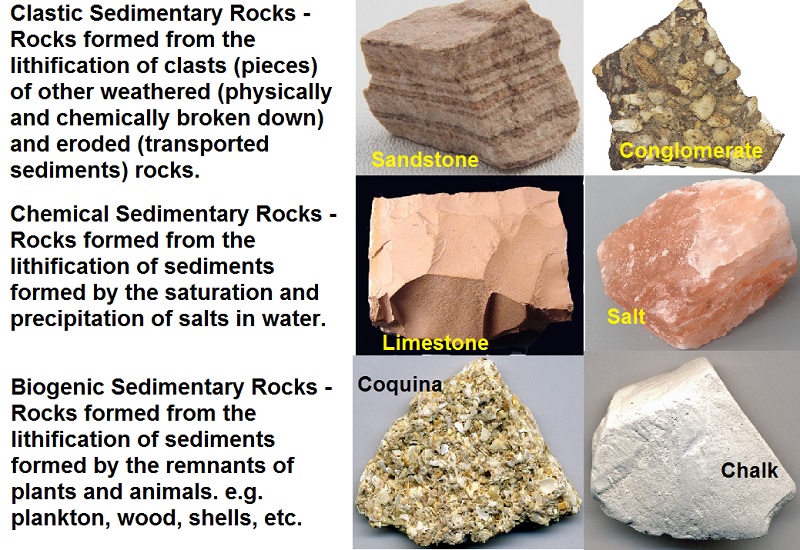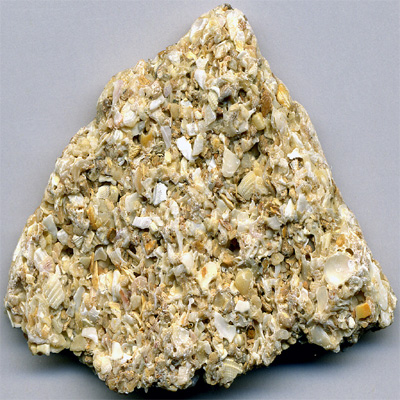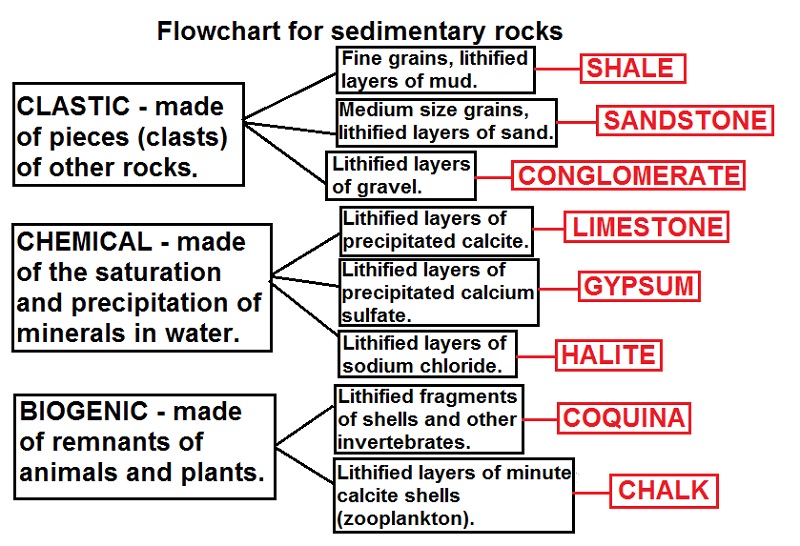SEDIMENTARY ROCKS


|
A thick sequence of muds, sands and gravels have been deposited as layers in a basin bounded by mountains (see figures below). These layers have turned into sedimentary rocks: the mud into shale, the sand into sandstone, and the gravel into conglomerate.
|
|
|
|
|
|
SHALE |
SANDSTONE |
|
|
|
|
The sediment MUD will become SHALE after the process of lithification (dewatering, compaction, cementation, and recrystallization). |
The sediment SAND will become SANDSTONE after the process of lithification (dewatering, compaction, cementation, and recrystallization). |
|
|---|---|
|
CONGLOMERATE |
|
|
The sediment GRAVEL will become CONGLOMERATE after the process of lithification (dewatering, compaction, cementation, and recrystallization). | |
|
|
|
|
All the weathered sediments are later transported (eroded away), mainly by rivers, to basins. In these basins these sediments will accumulate and later by the process of lithification (compaction, cementation and recrystallization) they will become rocks. |
|
|
|
|
The heaviest sediment (gravel) will be the first one to be deposited and after the process of lithication that GRAVEL will become a rock called CONGLOMERATE. Medium weight particles of SAND will travel a bit farther into the basin and once these particles are lithified, they will form a rock called SANDSTONE. The lightest particles mainly MUD consisting of clay and SILT will be deposited and lithified forming a rock called SHALE. |
|
In some locations, there are lateral gradations within a single layer, as illustrated in the figure above, where a conglomerate grades into a sandstone which grades into a shale. When this occurs, the grain size decreases as the distance away from the mountain front increases. |
|
|
|
|
|
The ability of moving water, as in a river, to transport sediment depends on flow velocity and on the size of the sediment being transported. Generally, high velocities can transport both small and large grained material, while slower flows can transport only the smaller size fractions. If a mixture of gravel, sand and mud is carried by moving water, which material is deposited first as the velocity of the water decreases? Which is deposited last, when the water has slowed down almost to a halt? |
|
|
First material de deposited __________________________________ |
|
|
Last material de deposited __________________________________ |
|
|
|
|
|
From these considerations, explain how those layers in which there is a change in grain size originated in the basin setting described. |
|
|
______________________________________________________________________________ |
|
|
______________________________________________________________________________ |
|
|
|
|
|
Limestone - All sedimentary rocks that are made principally of calcite are called limestone. Limestones have diverse appearances depending on their origins and on the character of substances they contain (often in minute quantities) other than calcite. All limestones will react to hydrochloric acid because they contain calcium carbonate. We will be studying three types of limestones. |
|
|
|
|
|
COQUINA |
LITHOGRAPHIC LIMESTONE |
|
|
|
|
Broken shells and calcium carbonate salts left by the remnants of marine animals will become COQUINA after the process of lithification (dewatering, compaction, cementation, and recrystallization). |
Calcium carbonate left over by corals, shells, and other marine animals will dissolve in water. This heavy concentration of calcium carbonate will saturate pockets of water and eventually these salts will precipitate to the bottom of a body of water. This fine mud will become LITHOGRAPHIC LIMESTONE after the process of lithification (dewatering, compaction, cementation, and recrystallization). |
|
|---|---|
|
CHALK |
|
|
Chalk under the TEM (transmission electron microscope). Millions of microscopic plankton die at sea (3/4 of the ocean are inhabited by plankton) and their minute skeletons deposit as blankets of sediments. This sediment will become CHALK after the process of lithification (dewatering, compaction, cementation, and recrystallization). | |
|
|
|
|
A) the shells of sea creatures such as clams accumulate along a shoreline. They are later buried and cemented together to form rock; |
|
|
Origin A results in specimen called _________________________________________ |
|
|
| |
|
(B) the calcareous (made of calcium carbonate) hard parts of minute or microscopic marine animals and plants accumulate on the sea floor to become part of a calcareous mud. The mud, upon burial, becomes dewatered, compacted and reorganized to form a very fine-grained, crumbly rock; |
|
|
Origin B results in specimen called _________________________________________ |
|
|
| |
|
(C) changes in the temperature, pressure or chemistry of lake water cause some of the calcium carbonate that is dissolved within it to come out of solution and be precipitated onto the lake floor to form an extremely fine- grained, even-textured mud. This mud, upon burial, becomes dewatered, compacted and reorganized to form an extremely homogenous, fine- grained smooth rock with very low porosity. |
|
|
Origin B results in specimen called _________________________________________ |
|
|
| |
|
Sedimentary
rocks are divided into three groups: CLASTIC, CHEMICAL, and BIOGENIC
sedimentary rocks.
|
|
CLASTIC
- Clastic sedimentary rocks are pieces (clasts) of other rocks that
have been compacted and cemented together to form from a loose sediment
a cohesive rock.
|
|
CHEMICAL - Chemical sedimentary rocks are formed by the saturation and precipitation of salts accumulated in lakes and seas. |
| BIOGENIC- Biogenic sedimentary rocks are formed by the accumulation of compacted plants or animals. |
 |
Name of rock = SHALE Type of rock = CLASTIC Composition = Layers of mud and clay became lithified Reaction to HCL = Non Reactive |
 |
Name of rock = SANDSTONE Type of rock = CLASTIC Composition = Layers of sand became lithified Raction to HCL = Non Reactive |
 |
Name of rock = CONGLOMERATE Type of rock = CLASTIC Composition = Gravel became lithified Reaction to HCL = Non Reactive |
 |
Name of rock = LIMESTONE Type of rock = CHEMICAL Composition = Minute parts and microscopic animals die and accumulate on the seafloor creating a calcareous (made of calcium carbonate) ooze that precipitates to form this rock. Reaction to HCL = Reactive |
 |
Name of rock = COQUINA Type of rock = BIOGENIC Composition = Shells of sea creatures that are compacted and cemented together Reaction to HCL = Reactive |
 |
Name of rock = CHALK Type of rock = BIOGENIC Composition = Calcareous mud produced by dead plankton that became lithified Reaction to HCL = Reactive |

©David Leveson and David Seidemann - Brooklyn College - Earth and Environmental Sciences







